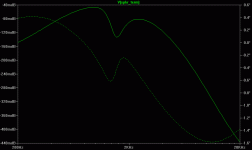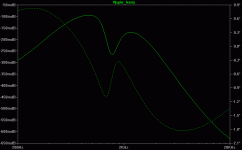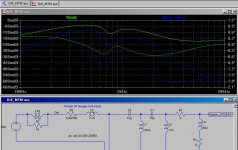And I thought it was electricity thru a conductor.
Seems you missed the quote that talks about "audio perceptions"
Electricity thru that conductor often causes death.
dave
Sorry, Im confused. This thread can be hard to follow sometimes.
SY doesn't seem to be far behind.
dave
Well, we ARE talking about a piece of wire. A single valued transfer function.
Into a complex load. Below, lumped parameter estimate of ten feet of 16 gauge, minus capacitance, into the PartsExpress Dr K MTM, again chosen for the well-documented Dayton drivers used. No wonder the MIT is potentially audible. Yes, only prosaic scientific reasoning is required to explain it, harder is it why reports were dismissed instead of metered.
Edit: forgot, my brother stumbled across this thread and reminded me of MLSSA tests he'ld done at either ends of speaker cables. The variance was over 0.8 dB, prompting to switch to heavy gauge afterward.
Attachments
Last edited:
Into a complex load. Below, lumped parameter estimate of ten feet of 16 gauge, minus capacitance, into the PartsExpress Dr K MTM, again chosen for the well-documented Dayton drivers used. No wonder the MIT is potentially audible. Yes, only prosaic scientific reasoning is required to explain it, harder is it why reports were dismissed instead of metered.
Oh, wow. That's interesting! Can you explain the "Four Twinned" cable?
Thank you for that data rdf. We need more of this and if I had a spare hour or two I'd do some tests too. Well, maybe not
It's been said earlier but bears repeating:
If your speakers are low impedance, difficult to drive, large phase range and your amplifier is high output impedance, low feedback, transformer/capacitor coupled then there's a high probability that changing cables will change the sound. As rdf's plot shows.
YMMV
It's been said earlier but bears repeating:
If your speakers are low impedance, difficult to drive, large phase range and your amplifier is high output impedance, low feedback, transformer/capacitor coupled then there's a high probability that changing cables will change the sound. As rdf's plot shows.
YMMV
Can you explain the "Four Twinned" cable?
Nope, don't know anything about it. From the pics MIT soldered an inductor inline, which can't help but have some impact at the top end. When the model used for the above trace includes National's 0.7uH output inductor and Zout estimate for a damping factor of 100, the results become:
Attachments
Iain, I would say it's low impedance speakers with high damping factor amplifiers that will see the most effect. The speaker wire impedance is in series with amplifier's Zout. If the latter is already twenty times greater than typical 16 gauge, which is the case of some tube SE gear, cable makes little relative difference.
Sharing some experience.
1. I have a class D amplifier here, the NCD. Originally it was just using a thickest power cord we could find on the market, which was primarily for power tools. Once someone wanted to try a Siltech power cable. We made the switch, and it was so umbearable that we took it out in less than 1 minute of listening. Some people swear by Siltech. But it seems there is much more involved than meets the eye.
2. I have a pair of the real early MIT 330 shotgun interconnect which a purchased after listening to them. I would just bring the cables around to different places to do a "shoot out", there was so significant an improvement that it chould be heard within the first minute of listening, and without any argument which was the winner.
3. We had a cable shootout around here a while back. One of the speaker cables
I brought in was braided as described in an old SpeakerBuilder magazine. As we when through the other cables, everyone was in discussion as to what the differences were. When this braided cable went up, everyone became silent. Afterwards, someone even asked to borrow it. I also had a pair of 3M old MIT-330. When this one when up, everyone wondered how could such dirty looking cable have such clean and good sound.
It is fully understandable that you like the MIT´s.
But they are not "monitor" cables in its purest sence, since they tend to do what they do on all recordings.
I´ve also tried out some MI330 series two, and the result was ecxactly what stood on the case, increased hight over your speakers (even on recordings where absolute no hight were present), sweet highs (also on all recordings) and deeper bas (always).
As you can read I really do not want that kind of colouration in my system, but I´m aware that some people do. I´d just not call it a good cable, as a good cable to me will be the one with the least sonic impact and highest fidelity, not the opposite, be it good or bad.
It is maybe a bit like roomcorrection, you are trying to correct or compensate for something that in fact should be solved directly, i.e. by treating the room acoustically.
If you remove the effect of the Zobel ....
The woofer Zobel? 12uF into 20 ohm? That should increase the midband impedance peak and the FR variance, as a side effect of destroying the x-over optimization.
That 0.8 dB number is in Paul Bunyan territory BTW.
Missed that. Suggesting my brother is a liar because you don't agree with his results would be pathetic, so that's probably not what you meant.
Another part of cable is the termination.
For speaker cables it is often banana plugs or spade lugs, also these have their sonic impact as a result of different material and/or different design and/or tension.
Normally it is not possible to use bare copper for this purpose, as this simply is to soft. Different copper alloys are more practical for this use, i.e. are telurium copper a very good conductor, and it also is very solid. Another possibility is Berylliumcopper also named Berylco, which is good for springs etc, which again makes it good for banana plugs.
In addition most copper alloys need to be coated with something not to become oxydised in time. Gold is the most used coating, because gold will not react with air, as it practically will not react with anything. But looking at direct goldplating, this normally looks less shiny than multilayer plating, thus most connectors are first nickelplated and then goldplated, which is less ideal than direct plating. Also Rhodiumplating is seen, as this is much harder than gold, and therefor it does not wear that much by heavy use.
If you do not belive in sonic characteristica of the termination, you should try 2 pairs of the same cable but with different termination, a suggestion could be like WBT 0645 seen here WBT-USA ,
and i.e Pomona 5406 http://www.pomonaelectronics.com/do...w.pomonaelectronics.com/images/large/1325.jpg
I think you are in for a surprice, if you never tried this before.
Much the same goes for RCA plugs, they sound different, although I think the largest differences are at the speaker cables.
But still not so subtle, that it is not worthwhile. I have some VdH cables witch are ecxactly alike, but with different RCA plugs, the sonic difference cannot be overheard.
Also once I´ve tried out these plugs, Neutrik - Audio - Profi - NF2C-B/2 , as they will connect ground before the hot one, therefor no annoying sounds will occur when connecting/disconnecting amps. But this is actually what I find the worst sounding plug I´ve ever encountered. It simply sounds as if there is no good connection, and the connection in addition sounds like bad material or something like that. They are btw. used by a famous vendor look here: Baldur Analog Interconnect from Nordost ,
When comparing cables it will thus be done at best, if connectors are either absent or the same, because they have sonic signature, and this will mudd up the real cable differences.
For speaker cables it is often banana plugs or spade lugs, also these have their sonic impact as a result of different material and/or different design and/or tension.
Normally it is not possible to use bare copper for this purpose, as this simply is to soft. Different copper alloys are more practical for this use, i.e. are telurium copper a very good conductor, and it also is very solid. Another possibility is Berylliumcopper also named Berylco, which is good for springs etc, which again makes it good for banana plugs.
In addition most copper alloys need to be coated with something not to become oxydised in time. Gold is the most used coating, because gold will not react with air, as it practically will not react with anything. But looking at direct goldplating, this normally looks less shiny than multilayer plating, thus most connectors are first nickelplated and then goldplated, which is less ideal than direct plating. Also Rhodiumplating is seen, as this is much harder than gold, and therefor it does not wear that much by heavy use.
If you do not belive in sonic characteristica of the termination, you should try 2 pairs of the same cable but with different termination, a suggestion could be like WBT 0645 seen here WBT-USA ,
and i.e Pomona 5406 http://www.pomonaelectronics.com/do...w.pomonaelectronics.com/images/large/1325.jpg
I think you are in for a surprice, if you never tried this before.
Much the same goes for RCA plugs, they sound different, although I think the largest differences are at the speaker cables.
But still not so subtle, that it is not worthwhile. I have some VdH cables witch are ecxactly alike, but with different RCA plugs, the sonic difference cannot be overheard.
Also once I´ve tried out these plugs, Neutrik - Audio - Profi - NF2C-B/2 , as they will connect ground before the hot one, therefor no annoying sounds will occur when connecting/disconnecting amps. But this is actually what I find the worst sounding plug I´ve ever encountered. It simply sounds as if there is no good connection, and the connection in addition sounds like bad material or something like that. They are btw. used by a famous vendor look here: Baldur Analog Interconnect from Nordost ,
When comparing cables it will thus be done at best, if connectors are either absent or the same, because they have sonic signature, and this will mudd up the real cable differences.
Another part of cable is the termination.
For speaker cables it is often banana plugs or spade lugs, also these have their sonic impact as a result of different material and/or different design and/or tension.
Normally it is not possible to use bare copper for this purpose, as this simply is to soft. Different copper alloys are more practical for this use, i.e. are telurium copper a very good conductor, and it also is very solid. Another possibility is Berylliumcopper also named Berylco, which is good for springs etc, which again makes it good for banana plugs.
In addition most copper alloys need to be coated with something not to become oxydised in time. Gold is the most used coating, because gold will not react with air, as it practically will not react with anything. But looking at direct goldplating, this normally looks less shiny than multilayer plating, thus most connectors are first nickelplated and then goldplated, which is less ideal than direct plating. Also Rhodiumplating is seen, as this is much harder than gold, and therefor it does not wear that much by heavy use.
If you do not belive in sonic characteristica of the termination, you should try 2 pairs of the same cable but with different termination, a suggestion could be like WBT 0645 seen here WBT-USA ,
and i.e Pomona 5406 http://www.pomonaelectronics.com/do...w.pomonaelectronics.com/images/large/1325.jpg
I think you are in for a surprice, if you never tried this before.
Much the same goes for RCA plugs, they sound different, although I think the largest differences are at the speaker cables.
But still not so subtle, that it is not worthwhile. I have some VdH cables witch are ecxactly alike, but with different RCA plugs, the sonic difference cannot be overheard.
Also once I´ve tried out these plugs, Neutrik - Audio - Profi - NF2C-B/2 , as they will connect ground before the hot one, therefor no annoying sounds will occur when connecting/disconnecting amps. But this is actually what I find the worst sounding plug I´ve ever encountered. It simply sounds as if there is no good connection, and the connection in addition sounds like bad material or something like that. They are btw. used by a famous vendor look here: Baldur Analog Interconnect from Nordost ,
When comparing cables it will thus be done at best, if connectors are either absent or the same, because they have sonic signature, and this will mudd up the real cable differences.
So Kurt,
In the end I think that you are saying that cables/termination do indeed have a sonic signature. Is that a fair assumption in your listening experiences?
Kurt,in practice there is no such a thing as a perfect wire.LRC and shielding are well understood and in the hands of engineers,diy'ers,even audiophiles can do wonders.What's left imo is a proof that different metals,different purities of the same metal and insulations can have an effect on sound.
Some years back,audioquest had three interconnect cables,the "competition X,Z and PRO".These were of the same design,same teflon insulations but different metals for the conductors.PRO was pure silver,Z was 6N copper and X was OFC copper.Using some same connectors these cables had dinstict effect on sound.Depending on your system,one could be chosen as a better or if you like more "perfect".I have mentioned these three cables in the past but I can't remember if there was any reply from anyone.I mention them again,for two reasons mainly.One is because these three cables could be the "ultimate" tools for a simple and effective test,for even the most hardcore engineer.And this,because you don't have to be a believer or an "audiophool"to be able to hear the differences they caused.One could expect silver to be different so the most important part is the differences between the two copper versions.Second reason,simply because there is no such thing as a perfect system either.Which brings to your comment(and others) on "accurate" reproduction.IMO there is no accurate reproduction either.Something to remind you of something you've heard somewhere,yes.Each and everyone however perceives sounds very differently.In fact I think that if there is a huge number and qualities of cables out there,there is an even grater number of ears and brains Music is a need and everyone's needs are satisfied in a personal and unique way.So in the end as far as music is consearned,imo,it is more about good/bad for each and every one of us, than "accurate".
Music is a need and everyone's needs are satisfied in a personal and unique way.So in the end as far as music is consearned,imo,it is more about good/bad for each and every one of us, than "accurate".
NOTE:All three aq cables had solid 0.6mm conductors.
Some years back,audioquest had three interconnect cables,the "competition X,Z and PRO".These were of the same design,same teflon insulations but different metals for the conductors.PRO was pure silver,Z was 6N copper and X was OFC copper.Using some same connectors these cables had dinstict effect on sound.Depending on your system,one could be chosen as a better or if you like more "perfect".I have mentioned these three cables in the past but I can't remember if there was any reply from anyone.I mention them again,for two reasons mainly.One is because these three cables could be the "ultimate" tools for a simple and effective test,for even the most hardcore engineer.And this,because you don't have to be a believer or an "audiophool"to be able to hear the differences they caused.One could expect silver to be different so the most important part is the differences between the two copper versions.Second reason,simply because there is no such thing as a perfect system either.Which brings to your comment(and others) on "accurate" reproduction.IMO there is no accurate reproduction either.Something to remind you of something you've heard somewhere,yes.Each and everyone however perceives sounds very differently.In fact I think that if there is a huge number and qualities of cables out there,there is an even grater number of ears and brains
NOTE:All three aq cables had solid 0.6mm conductors.
Last edited:
Iain, I would say it's low impedance speakers with high damping factor amplifiers that will see the most effect. The speaker wire impedance is in series with amplifier's Zout. If the latter is already twenty times greater than typical 16 gauge, which is the case of some tube SE gear, cable makes little relative difference.
IOW, it's down to LCR and frequency response. Welcome to my side.
Actually, I think the greatest audibility is for things like the old Watts, where there was an enormous impedance dip in the midrange.
Maybe we should let the philosophers design high end audio equipment.
They do, all too often. Which is why one is FAR more likely to get an incompetent piece of gear at high end prices than at mainstream pricing. (cough, cough... Jadis)
The woofer Zobel? 12uF into 20 ohm? That should increase the midband impedance peak and the FR variance, as a side effect of destroying the x-over optimization.
He's referring to the 700nH // 10R. (You plotted the sum of that + the cable).
And the point about referencing this to an equal length of better speaker cable is perfectly valid.
Given the nature of room acoustics, I hope that anyone trying this out for themselves in real life has a jig to comfortably hold their head in the exact same position, after returning from the other end of the living room to swap the speaker cables.
Attachments
Last edited:
- Status
- Not open for further replies.
- Home
- Design & Build
- Parts
- I don't believe cables make a difference, any input?


